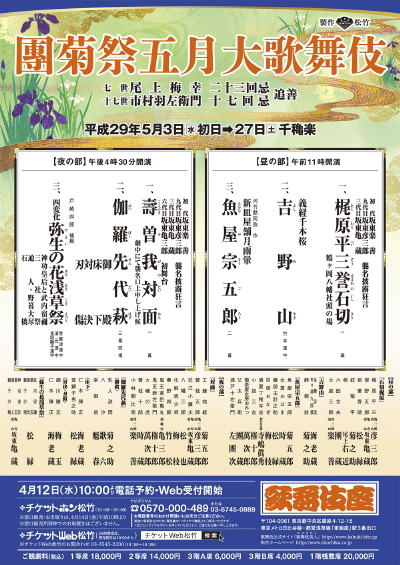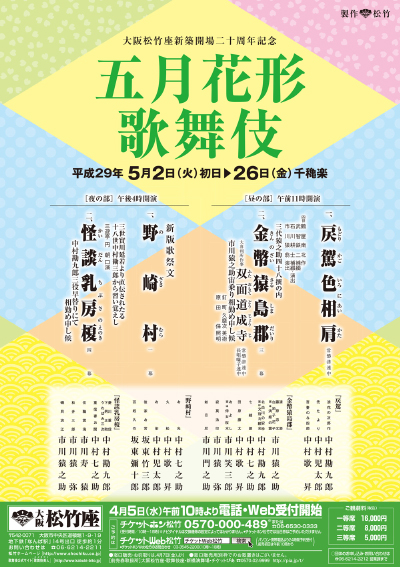| MAY 2017 |
|
5 shows in T˘ky˘ (Kabukiza, Meijiza, National Theatre, Orchard Hall), 2 in ďsaka (Sh˘chikuza) and 1 in Niigata (Niigata Kenmin Kaikan)!
|
| Kabukiza (T˘ky˘) |  |
| Dates | 3 ~ 27 May 2017 (Dankikusai Gogatsu ďkabuki) Dankikusai May Grand Kabuki |
| MatinÚe |
Kajiwara Heiz˘ Homare no Ishikiri |
| Evening |
Kotobuki Soga no Taimen
|
| Casting |
Living National Treasure Onoe Kikugor˘, Nakamura Tokiz˘, Nakamura Baigyoku, Nakamura Kaishun, Band˘ Rakuzen, Band˘ Hikosabur˘, Band˘ Kamez˘, Ichikawa Ebiz˘, Onoe Kikunosuke, Onoe Sh˘roku, Ichikawa Danz˘, Ichikawa Sadanji, Nakamura Karoku, Nakamura Baishi, Ichimura Manjir˘, Kawarasaki Gonjűr˘, Onoe Matsuya, ďtani Tomoemon, Ichikawa Udanji, Kataoka Ichiz˘, Ichikawa Udanji, Ichimura Kakitsu, Ichikawa Kudanji, Ichikawa Omez˘, Band˘ Minosuke, ďtani Hiromatsu, Ichikawa Otora, Ichimura Kitsutar˘, Ichimura Takematsu, Onoe Ukon, Band˘ Kamesabur˘, Terajima Maholo |
| Comments |
The great yearly Dankiku festival for the Naritaya and Otowaya guilds, which commemorates 2 great stars of the Meiji era: Dan = Ichikawa Danjűr˘ IX and Kiku = Onoe Kikugor˘ V. An important 3-generation shűmei for the Band˘ branch of the Otowaya guild this month at the Kabukiza! Band˘ Hikosabur˘ VIII, his two sons Band˘ Kamesabur˘ V and Band˘ Kametoshi respectively take the names of Band˘ Rakuzen, Band˘ Hikosabur˘ IX and Band˘ Kamez˘ III. Moreover, Band˘ Kamesabur˘'s son Band˘ Yűta makes his hatsubutai and receives the name of Band˘ Kamesabur˘ VI. Moreover, the 22nd and 16th anniversaries (23rd and 17th memorial services) of the passing away of Onoe Baik˘ VII and Ichimura Uzaemon XVII are commemorated. Another special event : Terajima Maholo, the grandson of Living National Treasure Onoe Kikugor˘ and son of the actress Terajima Shinobu makes his first stage appearance (omemie).
|
 |
| Sh˘chikuza (ďsaka) |  |
| Dates | 2 ~ 26 May 2017 (Gogatsu Hanagata Kabuki) May Young Actors Kabuki |
| MatinÚe |
Kin no Zai Sarushima Dairi |
| Evening | |
| Casting |
Ichikawa Ennosuke, Nakamura Kankur˘, Nakamura Shichinosuke, Band˘ Yajűr˘, Band˘ Takesabur˘, Ichikawa Monnosuke, Ichikawa Emisabur˘, Ichikawa En'ya, Ichikawa Juen, Nakamura Kotar˘, Nakamura Kash˘ |
| Comments |
Two Kabuki programs with young actors of the Omodakaya and Nakamuraya guilds. This is also the 20th anniversary of the Sh˘chikuza which is celebrated.
|
 |
| Meijiza (T˘ky˘) |  |
| Dates | 3 ~ 27 May 2017 (Gogatsu Hanagata Kabuki) May Young Actors Kabuki |
| MatinÚe |
Tsukigata Hanpeita |
| Evening | |
| Casting |
Kataoka Ainosuke, Nakamura Ganjir˘, Kataoka Kamez˘, Arashi Kitsusabur˘, Nakamura Jűjir˘, Kataoka Matsunosuke, Kamimura Kichiya, Nakamura Kazutar˘, Nakamura Matsue, Nakamura Kamenoj˘, Nakamura Hashinosuke, Ichikawa Fukutar˘, Nakamura Hayato, Nakamura Yonekichi, Nakamura Mantar˘, Nakamura Tanenosuke |
| Comments |
May Young Actors Kabuki performances at the Meijiza with a troupe led by Kataoka Ainosuke.
|
| National Theatre (T˘ky˘) |
| Dates | 11 ~ 22 May 2017 (Zenshinza Gogatsu K˘en) Zenshinza May Performances |
| Program |
Ura Nagaya S˘d˘ki |
| Casting |
Kawarasaki Kunitar˘, Arashi Yoshisabur˘, Fujikawa Yanosuke, Yamazaki Tatsusabur˘, Matsunami Kihachir˘, Tadamura Shin'ya, Seiganji Shigemori, Hayase Einoj˘, Arashi Ichitar˘ |
| Comments |
The usual Zenshinza May program at the National Theatre! "Ura Nagaya S˘d˘ki" is a newly-created drama which was written by the veteran movie director Yamada Y˘ji and which was based on two famous rakugo stories, "Rakuda" and "Ido no Chawan". |
| Orchard Hall (T˘ky˘) |
| Dates | 16 ~ 20 May 2017 (Band˘ Tamasabur˘ x Kod˘ Tokubetsu Buy˘ K˘en) Band˘ Tamasabur˘ x Kod˘ Special Dance Performances |
| Program |
Yűgen |
| Casting |
Living National Treasure Band˘ Tamasabur˘ |
| Comments |
Living National Treasure Band˘ Tamasabur˘ performs at the Orchard Hall along with the Kod˘ taiko drummers in a newly-created dance-drama entitled "Yűgen", which features an array of classical Japanese images from plays by N˘ founder Zeami Motokiyo, incorporating themes from iconic works such as "Hagoromo" (The Feather Robe), "D˘j˘ji" (D˘j˘ji Temple) and "Shakky˘" (The Stone Bridge). Band˘ Tamasabur˘ shares the stage with the dance master Hanayagi Jusuke IV and his disciples. |
| Niigata Kenmin Kaikan (Niigata) | |
| Dates | 26 ~ 28 May 2017 (Band˘ Tamasabur˘ x Kod˘ Tokubetsu Buy˘ K˘en) Band˘ Tamasabur˘ x Kod˘ Special Dance Performances |
| Program |
Yűgen |
| Casting |
Living National Treasure Band˘ Tamasabur˘ |
| Comments |
Living National Treasure Band˘ Tamasabur˘ performs in Niigata at the Niigata Kenmin Kaikan (Niigata Prefectural Civic Center) along with the Kod˘ taiko drummers in a newly-created dance-drama entitled "Yűgen", which features an array of classical Japanese images from plays by N˘ founder Zeami Motokiyo, incorporating themes from iconic works such as "Hagoromo" (The Feather Robe), "D˘j˘ji" (D˘j˘ji Temple) and "Shakky˘" (The Stone Bridge). Band˘ Tamasabur˘ shares the stage with the dance master Hanayagi Jusuke IV and his disciples. |
|
|
| Contact | Main | Top | Updates | Actors | Plays | Playwrights | Programs | Links | FAQ | Glossary | Chronology | Illustrations | Prints | Characters | Derivatives | Theaters | Coming soon | News |